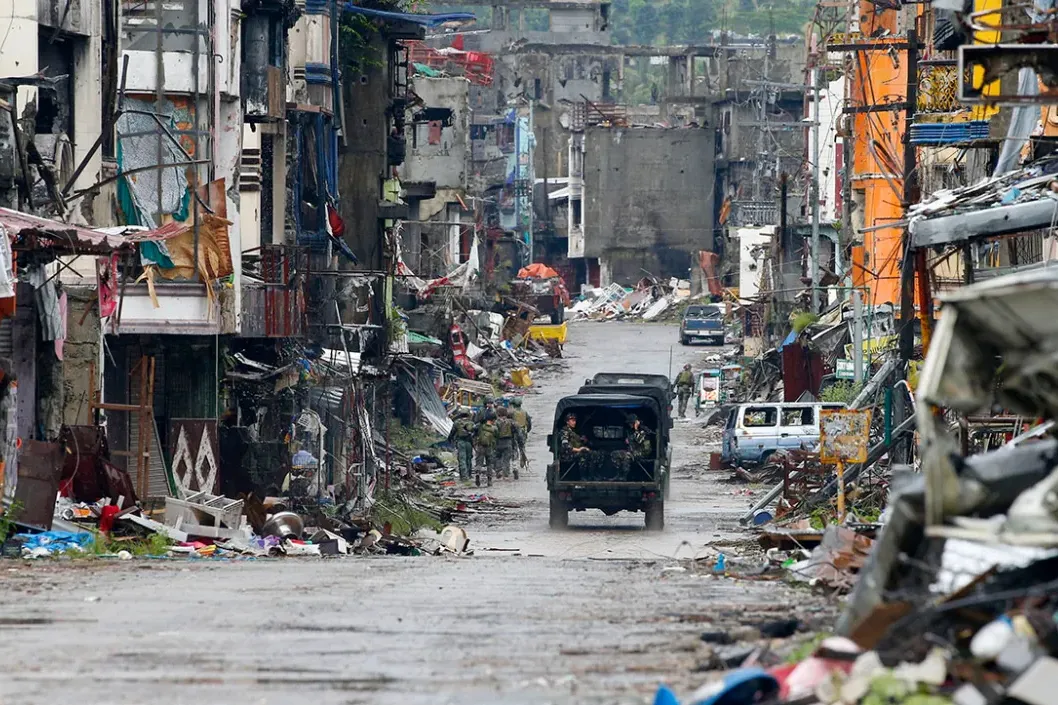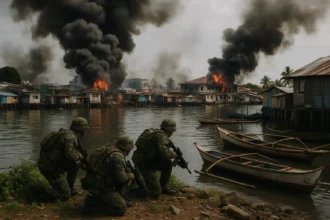Seven years now.
- The Anatomy of a Siege: Official Narrative and Lingering Doubts
- The Cost of Oversight: Intelligence Failures or Strategic Neglect? 🚨
- The Reconstruction Gold Rush: Who Truly Benefited? 💸
- Ground Zero: A Ghost City of Broken Promises 🏚️
- A Legacy of Abuse: Human Rights and the Wounds of War 💔
- The Anatomy of Betrayal: Disaster Capitalism and Displaced Faith
For those who lost homes, loved ones, and a lifetime’s sense of safety in the siege of Marawi, time has not healed—it has only deepened the wound. What began in May 2017 as an attempt to serve an arrest warrant spiraled into a five-month-long urban war that turned the Islamic City’s historic core into a battlefield. The Maute Group, waving the black flag of ISIS, seized the city. The government responded with overwhelming force. By the time the guns fell silent, Marawi lay in ruins, and over 350,000 people had been displaced.
The official narrative spoke of heroism, necessity, and victory. But as the smoke cleared and the rehabilitation funds trickled in slower than hope could survive, a different truth began to emerge. Billions were pledged, yet the city still stands as a husk of its former self. Behind the scenes, questions refuse to die: Were there warning signs ignored? Intelligence gaps brushed aside? Could Marawi’s fall have been prevented—or was it allowed to happen under the weight of bureaucratic neglect and political calculation?
From where I sit now, the story of Marawi feels neither distant nor closed. It’s a living scar—etched into our collective memory, a warning that security without justice is a hollow promise. The silence that hangs over Marawi’s ruins is deafening, filled with broken promises and unanswered questions.
Seven years later, the city still waits. So do its people. And so must we all—until someone has the courage to confront not just what happened, but why it was allowed to happen at all.
The Anatomy of a Siege: Official Narrative and Lingering Doubts
On May 23, 2017, the city of Marawi became the center of global attention as hundreds of ISIS-aligned militants, primarily from the Maute and Abu Sayyaf groups, went on a rampage. The initial government response was to declare Martial Law across the entire island of Mindanao, a move that harked back to the dark days of dictatorship and was met with both support and profound skepticism. For five months, the Armed Forces of the Philippines engaged in a grueling urban war, using heavy artillery and airstrikes to dislodge the well-armed and deeply entrenched militants. By the time the government declared victory in October 2017, Marawi’s city center, known as the Most Affected Area (MAA), was a wasteland of rubble and shattered concrete.
This official narrative of a decisive military victory, however, has always been overshadowed by lingering doubts. The speed with which the militants consolidated their control, their ability to stockpile an impressive arsenal of weapons in a military-heavy region, and the length of the conflict itself all raised questions. The story of a brave and victorious military, while true in some respects, failed to answer the fundamental question of how such a monumental security breach was possible in the first place.
The Cost of Oversight: Intelligence Failures or Strategic Neglect? 🚨
The rise of the Maute Group and its ability to turn Marawi into a warzone points to either a profound intelligence failure or, more ominously, a strategic neglect of the brewing extremist threat. For years, security analysts and local officials had warned of the Maute Group’s growing influence and its embrace of ISIS’s radical ideology. These warnings, it seems, either fell on deaf ears or were deliberately ignored.
- Failure of Coordination: The intelligence community, a complex web of military, police, and civilian agencies, was criticized for its lack of a unified command and for failing to share critical information. This bureaucratic and institutional friction allowed the Maute Group to operate with a degree of impunity, consolidating its power and recruiting new members under the very noses of government security forces.
- Underestimation of the Threat: The national government, perhaps blinded by a sense of victory over older insurgent groups, appears to have significantly underestimated the capabilities of the Maute Group. The group was not a ragtag band of rebels but a sophisticated and well-funded organization with deep local ties. The belief that they could be easily neutralized proved to be a catastrophic miscalculation.
- A Deliberate Choice?: Some theories suggest that the intelligence failure was not an accident but a deliberate choice. These theories, while speculative, point to the possibility that the government was more focused on securing peace deals with larger, more politically manageable groups, and that the Maute Group was seen as a fringe issue that could be dealt with later. This strategic neglect, according to some, allowed the group to grow unchecked, ultimately leading to a crisis that could not be contained.
This haunting question of whether the devastation of Marawi was preventable remains a critical point of contention. The cost of that oversight, whatever its cause, was the annihilation of an entire city and the displacement of its people.
The Reconstruction Gold Rush: Who Truly Benefited? 💸
In the wake of the siege, the government declared a massive and ambitious rehabilitation plan, pledging billions of pesos from both national coffers and international donors. The sheer scale of the promised funds—tens of billions of pesos—was meant to signal a new beginning for Marawi. But seven years later, the reality on the ground tells a very different story.
- The Disappearing Funds: The billions of pesos allocated for rehabilitation have seemingly vanished into a labyrinth of bureaucracy and opaque contracts. Critics and local residents alike have questioned the lack of a clear, public accounting of how the money was spent. The discrepancy between the vast sums of money allocated and the slow, visible progress on the ground has fueled widespread allegations of corruption and mismanagement.
- Contracts for the Connected: The rehabilitation of Marawi, a multi-billion-peso enterprise, became a gold rush for politically connected firms. Allegations persist that reconstruction contracts were not awarded based on merit or qualifications but on patronage and cronyism. The lack of transparency in the bidding process and the involvement of contractors with no prior experience in large-scale rehabilitation projects has led many to believe that the reconstruction of Marawi became a business opportunity for the elite.
The following table starkly illustrates the disparity between the promises and the reality of Marawi’s rehabilitation.
Ground Zero: A Ghost City of Broken Promises 🏚️
The most painful symbol of the rehabilitation’s failure is the state of Marawi’s MAA, or “Ground Zero.” Seven years after the siege, this once vibrant commercial and cultural heart of the city remains a desolate wasteland of collapsed buildings, overgrown vegetation, and twisted metal. It is a ghost city, a haunting landscape of broken promises where the scars of war are still fresh. The displaced residents, many of whom are still living in temporary shelters, are unable to return to their homes due to the slow pace of reconstruction and complicated land ownership issues.
- Bureaucracy as a Barrier: The rehabilitation effort has been plagued by bureaucratic red tape and a lack of coordination between the numerous government agencies involved. This has led to years of delays, with residents caught in a legal and administrative maze as they try to reclaim their land and begin rebuilding their lives.
- The Unspoken Land Question: The complex and often undocumented land ownership patterns in Marawi have been a significant roadblock to reconstruction. The siege created a perfect opportunity for the government to push through new land titling policies, which many residents fear will lead to the permanent loss of their ancestral lands to developers and powerful interests.
The haunting silence of the MAA is a powerful metaphor for the government’s inaction and the displaced people’s plight. It is a city frozen in time, a tragic monument to the long-term consequences of a war that many feel has been neglected.
A Legacy of Abuse: Human Rights and the Wounds of War 💔
The Marawi Siege was a war fought on all fronts, and its aftermath has been haunted by allegations of human rights abuses and civilian trauma.
- Abuses from Both Sides: While the Maute Group and ISIS were responsible for horrific acts of violence, including the killing of civilians and the taking of hostages, reports from local and international human rights organizations also documented abuses allegedly committed by government forces. These include the arbitrary detention, torture, and extrajudicial killings of civilians suspected of being collaborators.
- The Psychological Toll: The trauma of the siege and the subsequent displacement has had a devastating psychological toll on the residents of Marawi. The loss of loved ones, the destruction of their homes, and the prolonged uncertainty of their future has created a generation that is grappling with profound grief and a deep sense of injustice.
- A Legacy of Mistrust: The allegations of human rights abuses and the slow, mismanaged rehabilitation efforts have eroded public trust in the government. The residents of Marawi, already a marginalized community, feel a renewed sense of betrayal and a deep-seated suspicion of the government’s intentions.
The wounds of Marawi are not just physical; they are psychological and emotional, and they continue to fester as the promise of justice remains unfulfilled.
The Anatomy of Betrayal: Disaster Capitalism and Displaced Faith
Marawi, in many ways, has become a tragic case study in disaster capitalism. The siege, a national disaster, was not just a military operation but a political and economic opportunity that was allegedly exploited by powerful interests. The idea that a disaster can be used to push through radical economic policies and benefit private firms is a theory that resonates deeply with the Marawi experience. The reconstruction of the city, a multi-billion-peso project, was framed as a business opportunity, not a humanitarian necessity.
The most profound failure of the Marawi Siege is a failure of empathy and human decency. The prolonged suffering of the displaced families, the apparent disregard for their plight, and the allegations of corruption surrounding the funds meant to rebuild their lives all point to a breakdown of a sacred trust. The Muslim community of Marawi, a community that has long felt marginalized by the national government, now feels a profound sense of betrayal. The city’s agony, they believe, was not a priority; it was an unfortunate byproduct of a war that has been mismanaged and exploited for political and economic gain.
As we stand seven years removed from the devastation, the silence of Marawi speaks volumes. It is a silence that echoes with the unanswered questions, the broken promises, and the lingering pain of a community betrayed. We must demand accountability and ensure that the lessons of Marawi—lessons about the complexities of extremism, the human cost of conflict, and the critical importance of good governance and genuine compassion—are not forgotten. The ghosts of Marawi deserve justice, and the displaced families deserve more than just empty promises; they deserve a future rebuilt on trust, transparency, and a renewed commitment to human dignity.




